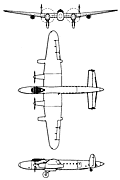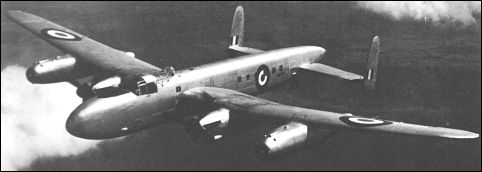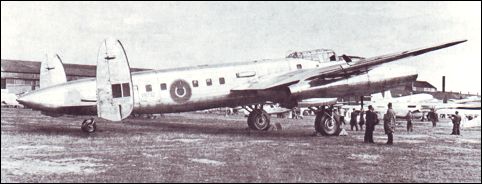|
| The Lancastrian, a high-speed transport derived from the Lancaster bomber, was an ideal vehicle for testing the new jet and turboprop engines that were becoming ready for flight testing from the end of World War II. Some of these engines were for combat aircraft, but even so needed endurance flying to enable them to mature quickly and become reliable and well developed before being fitted to new civil machines.
First to fly was Lancastrian VH742, delivered to the Rolls-Royce flight development airfield at Hucknall in October 1945. Its outer Merlin engines were removed and the nacelles were also taken away, while the fuel system was completely rebuilt to carry both gasoline for the inner engines and kerosine for the new jets. In the outer positions were added completely new nacelles housing Nene turbojets, then the most powerful jet engines in the world. It flew again on August 14, 1946 with two Merlins and two Nenes.
On September 19, 1946 this aircraft acted as the world's first jet airliner by making three passenger flights carrying representatives of the Press as well as Ministry officials and other passengers (who were all most impressed and suggested that an airline that could offer jet travel would be the talk of the world). Rolls-Royce also flew a second Nene-Lancastrian, VH737, and two Avon-Lancastrians, VM732 and VL970. The latter was used for almost six years, its later flying being concentrated on the Avon 502 civil turbojet for the Comet 2 airliner.
The original engine for the first jet airliner to enter service, the Comet 1, was the de Havilland Ghost 50. This was tested in the outer positions of Lancastrian VM703, first flown with the jets on July 24, 1947. As the original intention with the Comet was to use rockets to boost thrust on takeoff, VM703 was also used to test the only rocket then available, the captured German Walter 109-500, two of which were fixed under the fuselage. A second Ghost-Lancastrian, VM729, handled the final development and certification flying of the Ghost 50 for the Comet 1 so that Comet development from July 1949 began with a reliable and mature engine.
Among other jet Lancastrians were VM733 with Armstrong Siddeley Sapphires, and various test-beds with the Canadian Orenda, Swedish Dovern and the British ASX, Adder and Viper. Turbo-props included the Dart, Mamba and Python.
Bill Gunston "The Illustrated Encyclopedia of Commercial Aircraft", 1980
 | A three-view drawing (894 x 1338) |
| CREW | 3-9 |
| ENGINE | 2 x Rolls-Royce Merlin piston engines + 2 x Rolls-Royce Nene or Avon |
| WEIGHTS |
| Take-off weight | 29484 kg | 65001 lb |
| Empty weight | 13517 kg | 29800 lb |
| DIMENSIONS |
| Wingspan | 31.09 m | 102 ft 0 in |
| Length | 23.42 m | 77 ft 10 in |
| Height | 5.94 m | 20 ft 6 in |
| Wing area | 120.5 m2 | 1297.05 sq ft |
| Geoff Holling, e-mail, 04.03.2023 01:36 I was curious as to whether there was any speed advantage to powering the Lancaster with jet engines? or did speed have to be limited to preserve the integrity of the air frame? reply | | gerry roper, e-mail, 05.04.2020 00:36 i remember seeing one of thr lancastrians flying from horsham st faith over hellesdon school around 1950. reply | | Sqn Ldr GHD Shelley RAF, e-mail, 23.02.2017 21:44 During the latter part of my 7 year Apprenticeship at Rolls Royce Hucknall I flew as a Flight Test Observer(being paid two shillings an hour flying pay!!!)on a variety of aircraft with the Exhaust System Development Section. During my tine as a FTO I completed six flights in Lancastrian VM 742. My first Flight was on the 23rd May 1947 and the pilot was Captain Ron Shepherd, Chief Test Pilot at RR Hucknall. I also flew with Mutt Summers on Noise Evaluation Trials in Nene powered Viking VX 856 from Wisley in July 1948. Joining the RAF in December 1948 and later flying in the Nene Engined Ashton WB 492 on Radar Research at RAF Defford with my first flight on 30th November 1953. A most interesting and enjoyable time in my flying career having flown in the first three jet engined passenger airliners!! reply | | anonymous, 07.04.2015 00:13 "....would be the talk of the world" not so "talk" of the world reply | |
| | Brian Hughes, e-mail, 22.11.2012 00:49 I made a mistake with the date it was 1954
soory. reply | | B Hughes, e-mail, 18.11.2012 00:09 I was Stioned at 34 MU Stoke Heath at the end of 1994 and a Lacaster Test bed flew in for break up,. It had 4 mirlin and a Napier turbo in the nose. is there any info on it. reply | | Neil Harrison, e-mail, 05.10.2012 17:54 Does anyone have a photograph of sufficiently good quality of the Lancastrian VM703 test-bed for the de Havilland Ghost? I'm looking for such to illustrate an article about the development of the Ghost for the Comet 1 to appear in the next edition of Pylon, the occasional maagzine of the de Havilland Aeronautical Technical School Association. reply | | malcolm reed, e-mail, 03.05.2010 18:26 i would like to find more information on the Lancaster test bed as my late grandfather IVOR SOUCH was involved in building the 1st test bed then was involved in building a second for i believe was the Swiss air force and so my nan tells me he flew over with a test pilot and sat on a wooden chair in the bomb bay area for the entire flight the purpose of the visit was to demonstrate the operation of the test bed he was away for two weeks i cant find any more info and would like to now more my grandfather signed the official secrets act and toke it all to the grave when he died along with the top secret work fitting top secret updated guns and bombs to spitfires mustangs p25 etc at Hamble airfield where he worked for AST reply | | Arthur Compton, e-mail, 23.02.2010 17:57 I was preparing to Leave RNAS Eglington Northern Ireland and return to England for Christmas leave 1948, when a tannoy announcement advised that two spare seats were available on an aircraft travelling from nearby RAF Ballykelly. I immediately requested one of theses and was accepted. On arriving at Ballykelly, I was told that the aircraft was full but not to worry as another aircraft was on its way. Imajine my surprise when the aircraft landed and had two inline engines and two jet engines. The main fuselage was then completely filled with turkeys resulting in my standing behind the pilot throughout the journey. It was a quick turnround at Ballykelly as the pilot had to keep his engines running.We landed a short while later at Hucknall and I gained an extra days leave with my parents.
I look back fondly at such a remarkable experience for a nineteen year old Airframe Mechanic. reply | | 'Robbie', e-mail, 28.03.2009 20:43 I clearly remember one of these Lancaster flying test beds flying low over the North airfield at Cranwell sometime in in 1953 /4. For a moment it really startled me as I thought for a few seconds that it had lost 2 engines and was about to crash ! I was 14 at the time, and was out poaching rabbits, which was how I earned my pocket money in those days ! My late father was and air traffic controller at Cranwell at the time. reply | | Richard Gosnell, e-mail, 16.12.2008 22:06 My father flew in a Gohost-Lancastrian (VM ???)as one of 7 passengers on Sept 1, 1947. The pilot was Mr Beaumont. Notes recorded were:- "Press photographs (2 Merlins 2 Ghosts 165 IAS at 10000 ft on 2 jets only at cruising 8500 RPM)" reply |
|
Do you have any comments?
|
| 
COMPANY
PROFILE
All the World's Rotorcraft
|








